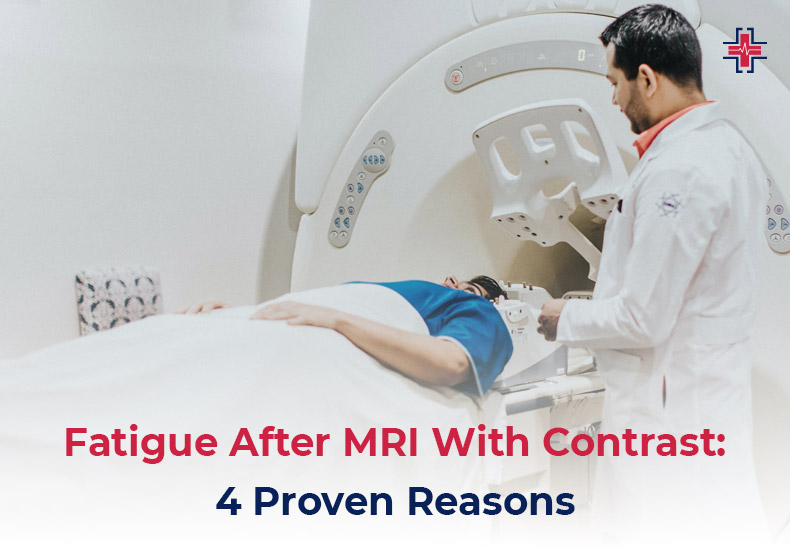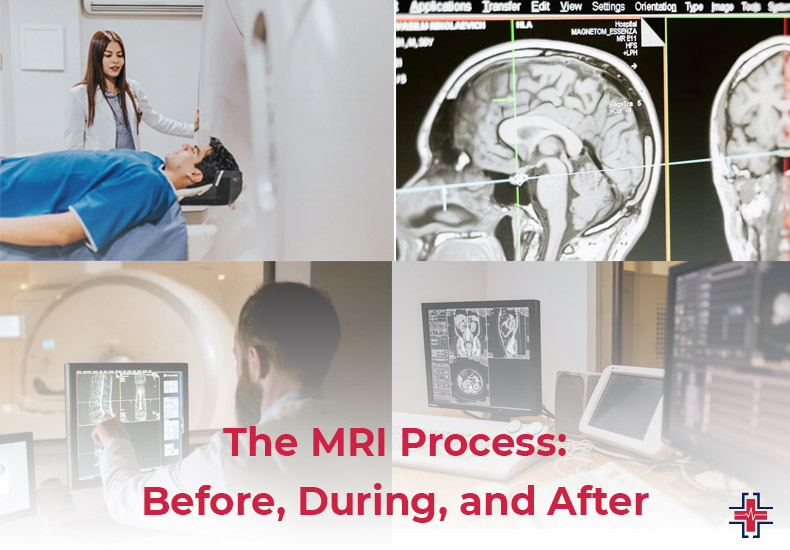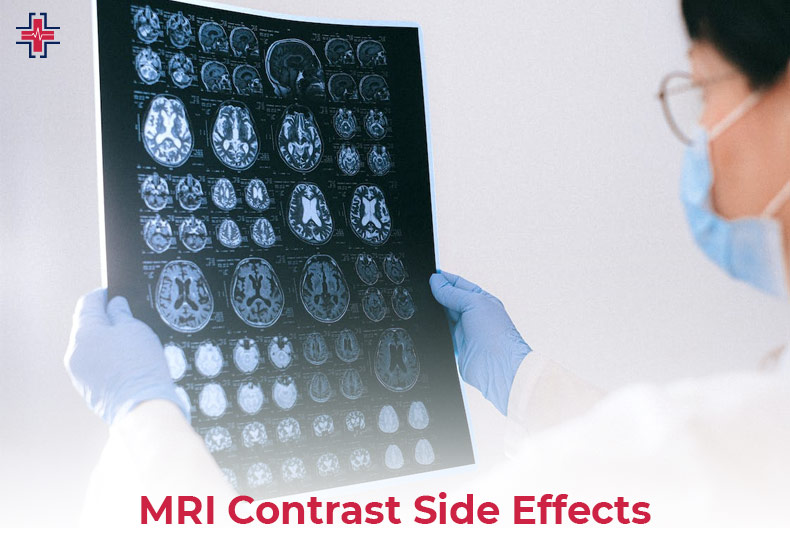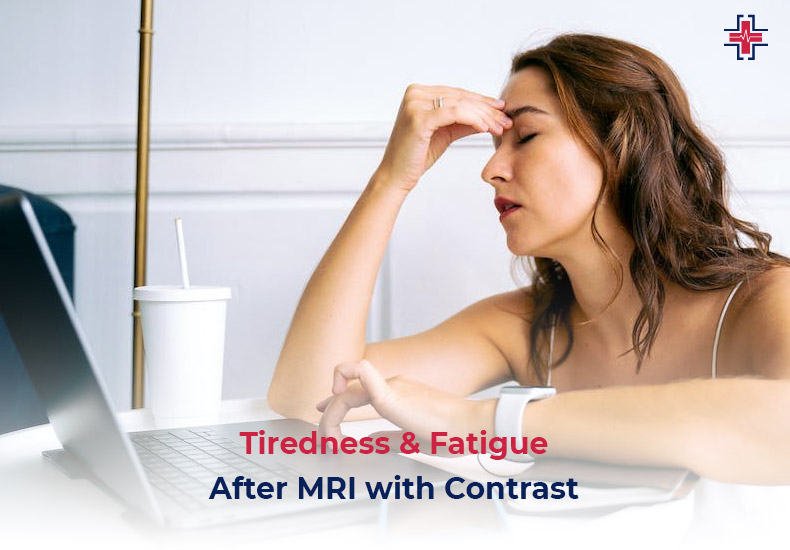Patients may experience fatigue after MRI following a contrast-enhanced MRI. The contrast dye used during the MRI is the main cause of post-scan nausea and vomiting. After an MRI, a lot of people frequently report having flu-like symptoms. This dye is also used in MRIs and angiograms to unlock the secrets of the human body. Moreover, an MRI is used to diagnose major illnesses or to rule out any extremely dangerous problem.
The solution of contrast dye is liquid. It’s critical to comprehend how a contrast dye functions. The contrast dye itself stands out from bodily tissues because of its brilliant white appearance. Contrast dye, on the other hand, is a changing agent used in MRI examinations.
There is an alteration in the nuclei’s relaxation time. This will alter the image. Contrast can be used to highlight particular blood arteries that are crucial for diagnosis. It can also indicate when a larger blood flow is directed toward a specific area of the body. It can also assist in locating any internal bleeding. Let’s investigate the various kinds of contrast media in more detail.
What Is an MRI With Contrast?
Using a powerful magnetic field and radio waves, an MRI scan can provide you with precise pictures of the structures inside your body. An MRI with contrast, however, can give your doctor a more in-depth image if necessary. Before the MRI starts, a contrast agent is injected intravenously to improve the quality of the imaging.

You may be better acquainted with one form of imaging technology, magnetic resonance imaging (MRI), and its benefits to healthcare due to its global ubiquity and improvements in medical imaging technology. An MRI machine is perhaps best known to you as a big, cylindrical device that surrounds you with a powerful magnetic field. It takes incredibly precise images of the soft tissues in your body to give your doctor important diagnostic and prognosis data.
However, you may not be aware of how important contrast is to an MRI. MRIs are distinct from other imaging modalities such as CT scans and X-rays because gadolinium-based contrast agents (GBCAs), a kind of MRI contrast dye, may be used to help enhance the clarity and interpretability of your MRI image.
You can find out more about this technology below if you want to schedule an appointment at the ER of Mesquite Imaging for an MRI with or without contrast.
Who Needs an MRI With Contrast?
Your doctor must authorize and order an MRI scan with contrast. The gadolinium-based dye will be intravenously injected into your arm during the treatment. By improving the image quality, the contrast medium gives the radiologist greater precision and assurance in their diagnosis.
Your internal organs do not become permanently discolored by the contrast medium dye. Rather, it modifies your body’s perception and interaction with imaging modalities momentarily. Following the imaging test, the contrast substance is either absorbed by your body or excreted through urine.
Not every MRI calls for the use of a contrast material. Both contrast-enhanced and non-contrast MRIs are useful diagnostic tools; your doctor will choose the appropriate scan for you based on your current health and medical history. However, the doctor will usually order the contrast agent if they need very precise imaging to evaluate a particular area of your body that is causing problems.
The radiologist can see more of the following when they apply contrast to your veins:
- Growths Inflammation
- The blood supply to specific organs
- Vascular structures
Even though a contrast MRI gives the physician useful information, they usually won’t prescribe one unless they believe it is required. For example, intravenous contrast tests are typically not necessary for back discomfort, sports injuries, or work-related injuries.
Uses of an MRI With Contrast
MRIs using contrast are sometimes used for:
Cancer Diagnoses
A radiologist can more easily identify tumors as they begin to form if they apply MRI dye during your test to enhance the detail of certain soft tissue areas. It may be more difficult for the radiologist to identify a tumor if it is only now starting to grow.
Evaluating MS
A fantastic method for monitoring the course of multiple sclerosis is to use contrast MRIs. Because MRI scans show lesions relatively clearly, they have replaced CT scans as the major approach used by clinicians to diagnose multiple sclerosis (MS). MRI scans have completely changed the way radiologists diagnose the disorder.
Contrast MRIs are not required, nevertheless, to diagnose MS. Even yet, lesions are typically quite easy for doctors to identify. However, a contrast-enhanced MRI picks up newly developing lesions, enabling medical professionals to gauge the disease’s rate of advancement. They also assist the physician in determining the kind of MS a patient may have, which includes:
- Principal progressive MS
- Supplementary upward MS
- MS remitting and relapsing
Clarity of Image
By highlighting particular soft tissue areas, the MRI scan with contrast aids the radiologist in diagnosing your illness. Using contrast with the MRI scan makes it easier for the radiologist to spot tumor growth or other serious changes.
Because flowing fluid, like blood in your arteries, is invisible to the naked eye during a typical MRI scan, the dye helps highlight your bloodstream. Without the dye, your veins and arteries appear as “flow voids” and look plain black on your scan.
An MRI With Contrast is Safe
It makes sense to question if there are any safety issues with the contrast material used in MRIs. Organs and other structures show differently in imaging for a brief time when contrast material is applied. It doesn’t result in long-term discoloration. After the imaging study is over, the substance will be eliminated by your body through bowel or urine movements.
Most forms of contrast dye, including gadolinium, the most often used type for MRIs, have very few side effects or allergic responses. On the other hand, certain allergies or medical problems like kidney illness can raise the possibility of adverse effects.
You will be asked health-related questions before the MRI so the technologist can assess whether you have a higher risk of adverse effects. Provide accurate answers to questions so the technician is aware of any allergies or medical issues you may have, along with any drugs you may be taking.
Fatigue After MRI With Contrast: Proven Reasons
Everyone who has an MRI feels strange afterward, and there could be several causes for this disorienting sensation.
After those many hours of lying down in a quiet position, your psychological state may be the cause in some cases and a physical one in others!
The strange feeling can sometimes be a reaction to sedatives, and other times it can be a reaction to your first MRI experience.

An Enclosed Tube Staycation of 90 Minutes
The extended stay you had inside the MRI machine could be another factor contributing to your strange post-scan feelings!
Even though an MRI usually takes 15 to 20 minutes, you can need to spend up to 90 minutes there depending on the imaging! You will have to put up with the cramped atmosphere for the duration!
Yes, it is correct!
The MRI machine is long and narrow, shaped like a doughnut when closed, and it seldom ever opens to let in fresh air! The machine seems like a dank, gloomy prison because of the loud noise above it and the heat and sweat inside.
You have to remain conscious and aware, remain motionless in one spot, and pay attention to cues on whether to change or relocate! Yes, it is tiring! During this period and long after the exam is over, feelings of stress and anxiety, anticipation and trepidation, and dread about being trapped may surface.
Thus, After the tense MRI scan, you could feel strange even if you don’t often get claustrophobic episodes!
Pee Release Takes a Long Time
Unfortunately! You must urinate when inside the MRI scanner, even if you are someone who cannot hold it in for longer. However, part of your preparation for the MRI scan is to consume a lot of clear liquids!
That is a rather big issue! You are unable to avoid consuming excessive amounts of fluids before the test or to pause it midway to use the restroom. All you can do will be to wait! It might be the cause of your strange post-MRI symptoms.
In reality, holding pee for an extended time can frequently result in abdominal pain that may not go away even after the urine has been flushed out.
Sedatives & Contrast Dye Aftereffects
You might occasionally be given contrast dye during the MRI scan to improve the clarity of the images. Additionally, Sedatives may occasionally be administered during an MRI to prevent claustrophobia in the equipment.
There is a chance of adverse repercussions in both scenarios. That could be the cause of your unease or strange feelings following the MRI scan. In addition to feeling exhausted and lightheaded, you could also experience chills, fever, headache, nausea, and body aches. Additionally, you might experience allergic reactions, sore throats, redness in the intervention area, etc.
This strangeness is similar to a red alarm, indicating that you might need to get ready to overcome the negative effects, which will probably happen soon. Are you ready for it?
A Loud Noise That Is Coming From The MRI Machine
I have to admit, even though your doctor won’t tell you this very often, an MRI scan is noisy. There would be a scratchy noise coming from the MRI machine when you were lying inside it all the time. How and Why?
Alright, The MRI machine’s coils expand when current flows through them while the scanner is operating, which is what makes the loud noise. It sounds like a jackhammer, with loud bangs and clanks one after the other.
It seems sense that the sound is unpleasant to listen to and could irritate people long after the MRI is finished.
Additionally, There are moments when the sound is as loud as 130 dB. Therefore, it could be the cause of your strange post-MRI feelings. You feel strange every time you get a flashback of those awful creaking noises as if you can never get over them!
MRI Scan After Long Fasting Hours
Did your physician advise you to abstain from food for six hours before having an MRI? Are you following her instructions in the letter?
Next, It could be an additional reason for your strange post-MRI feelings, and it suggests that you should eat something to feel better and more relaxed!
This is typical of every pathological exam where you have to fast for several hours to maintain the test’s accuracy to the last degree. Nothing is wrong with you! You shouldn’t turn away when someone advises you to do something that can provide you with an accurate assessment of your current state of health.
Additionally, You must have been hungry after putting yourself through such a demanding exam for so long. Without a doubt, hunger always makes us feel strange and anxious!
Is it Possible to Feel Fatigued After an MRI With Contrast?
Patients ask this question the most frequently. You may feel lightheaded following a contrast-enhanced CT scan. Patients have occasionally complained of feeling sleepy and disoriented. However, there is no evidence in medical studies linking weariness to contrast dye. The aforementioned dyes are all comparatively harmless and have minimal documented adverse effects.
However, their underlying medical conditions may be the cause of these negative consequences. Numerous publications detail the allergic reactions to contrast dye, including hyperthyroidism, color sensitivity reactions, and the induction of nephropathy.
Additionally, the clinical evidence indicates that there is a significant risk of disease exacerbation for those who have myasthenia gravis. Furthermore, patients may experience anaphylactic shock. This is not likely to happen, but it is possible.
This may occur following rectal and oral dye infusions. Your physician will assess your physical condition before following premedication treatments. Patients should stop using oral anti-infectives and other prescriptions 48 hours early.
The MRI Process: Before, During, and After
An MRI may be prepared relatively easily. You can consume food, liquids, and medications as usual before your session. Before your scan, make sure to take off any jewelry and body piercings. Put on comfortable, loose-fitting clothing, ideally free of metal fasteners like buttons, zippers, and underwire bras. You will be provided a hospital gown to change into if there is any metal in or on your clothing. Make sure you avoid wearing cosmetics or deodorant to your visit since these items may contain tiny metal fragments that could heat up in the MRI machine and cause harm to you.

You can bring what you need to your appointment, but please leave your purse and any other valuables—such as your wallet, cell phone, keys, etc.—in a locked locker. It’s crucial to leave credit cards behind because the MRI equipment is like a big magnet that can erase them. A metal bed that slides into a sizable magnetic tube with a donut shape makes up the MRI machine. This tube has an aperture of about 60 centimeters. You might be surprised by that size, but the tube must be that small for the radio frequency to generate the magnetic waves needed to take pictures of your interior.
At the ER of Mesquite has you covered if the tube’s size worries you in any way; we provide substitute devices that are more roomy and comfortable. Additionally, we have MRI machines with wide-bore openings, which are 10 cm broader than those of standard MRIs. The only area of your body that is enclosed in an open magnetic resonance imaging (MRI) machine is the area that is being imaged.
After the Test MRI
All you have to do is get back into your clothing, get your belongings, and carry on with your day. Furthermore, there are no limitations on what you can accomplish following the test. You’re free to depart after your scan. You will require a driver to take you home if you were given any sedative. An MRI scan has no negative side effects. Certain people report feeling fatigued following an MRI scan; this is typically due to the intense anxiety associated with the procedure. Fatigue can arise from the mental strain of getting ready for an MRI, traveling to your appointment, and waiting for the findings. Be sure to let your doctor know if any side effects, such as nausea or itching at the injection site, continue if you have an MRI with contrast.
How Long Does An MRI Take?
Your MRI consultation may last anywhere from 30 minutes to more than two hours because the technology can capture precise, high-quality images of numerous body areas. The scan itself should take a maximum of 15 to 90 minutes. Your appointment will likely take 1.5 to 2 hours due to the time required to change into new clothes and review your medical history. This may seem lengthy, but MRI scans yield the clearest and most accurate data, so they are well worth the additional time if you consider it an investment in your health and well-being.
As we have already established, the duration may vary based on the scanned object. The following are the times for various typical scans:
- Head MRI: 30 to 60 minutes
- Brain MRI: between 30 and 2 hours
- MRI of the back: 30 to 1 hour
- MRI of the spine: 30 to 2 hours
- An hour to 1.5 hours for a full-body MRI
The majority of the time during your MRI appointment is outside your control. Being punctual for your appointment and maintaining extreme stillness throughout your scans will help ensure that none need to be redone, expediting the process. Emerging technologies have the potential to expedite the MRI procedure. We at the ER of Mesquite assure you that we will continue to be at the forefront of emerging technology and are thrilled to witness the development of these new MRI machines.
MRI Contrast Side Effects
The most typical MRI side effects include weariness, disorientation, and backaches that might result from spending a lot of time lying down in a small area. Any MRI contrast agent employed has the potential to cause more severe side effects. In extremely rare cases, the MRI machine may push a metal object that is inside the body, potentially leading to major harm. Since there are strict safety measures in place to guard against this kind of incident, this side effect is quite uncommon.

People frequently have MRI side effects that appear to be brought on by the magnetic resonance imaging process but are the result of remaining motionless for extended periods. It is most likely that lying still on a hard surface for an hour or longer is what caused the dizziness and backaches that some patients have noticed. Stress from taking the images can be more taxing than is evident during the process, which is commonly the source of fatigue After MRI. Headaches are common MRI side effects, more likely in those who also have migraines, and are frequently linked to the loud noises heard during an MRI.
Dizziness: Why Does it Occur With MRIs?
One of the most frequent adverse effects of MRIs is dizziness. As was already indicated, the entire process may be the cause of the ailment, but research indicates that the scan’s powerful magnetic field may also have contributed. The magnet has the same effect on the inner ear balance that individuals with vertigo diagnoses encounter. Furthermore, the dizziness gets worse if the patient gets up from the table too soon. Additionally, the brain must acclimate to being outside of the machine once more. Thankfully, the dizziness is transient and does not result in any long-term issues. After their dizziness, some individuals may feel fatigued, but nothing that a little well-earned slumber can’t remedy.
An MRI Scan Can Cause a Headache
Headaches can occur in certain individuals following an MRI scan. Although the precise reason is unknown and varies depending on the circumstances, some elements are involved.
If the patient experiences headaches following the scan, the environment in general may be to blame rather than the specific treatment. The patient remains motionless on a moving table as you are brought into the MRI scanner. One could feel cramped by the machine’s compact design and closed-in atmosphere. You have to remain motionless as much as possible after the scan starts. Thus, concentrating on remaining still while worrying about a potential medical ailment and enduring whatever discomfort you may have are surefire ways to end up with a headache brought on by stress.
The duration of the scan may also have an impact on your post-scan mood. Depending on the body part being scanned and the intended use of the scan, scan times can range from 15 to 90 minutes. As a result, a patient may experience a headache when they first stand up after spending a lot of time on their back.
Bottom Line
Are you still reading the blog? And with that, I must say, we’re done for today. The main takeaway from this blog is that there are a variety of reasons why you could feel strange after an MRI scan; the key is to figure out which of the various causes applies to you.
At the ER of Mesquite – Emergency Room, we are dedicated to providing our patients with courteous, prompt, and helpful service, along with exceptional hospitality and knowledge.
We will do everything in our power to make sure you have a friendly and enjoyable experience at any of our imaging centers. We only keep up with the newest, most cutting-edge imaging equipment, so your results are consistently accurate and dependable.
Your MRI with contrast scan and CT Scan appointment will be scheduled and timed as conveniently as feasible. We’re prepared to assist you. ER of Mesquite can be found in your own space. Select a nearby center to make an appointment for your MRI scan with contrast.
